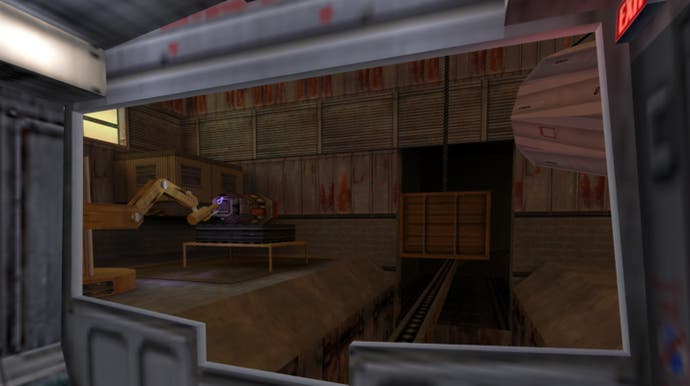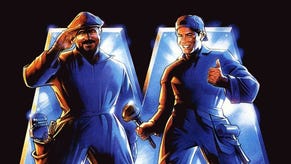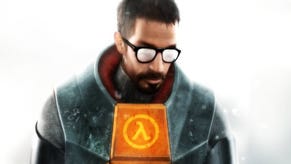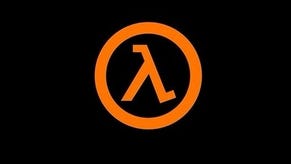20 years on, Half-Life's opening tram ride is still an audacious bit of theatre
On rails.
Somehow, it has been 20 years since the release of Half-Life. Which means, I guess, that it has been almost 20 years since a friend came back one night to the student house we were all renting and told me about this amazing game he had played. A first-person shooter - did we call them that back then? - in which, for the opening section at least, you did no shooting.
Instead, you...what? You rode a tram to work in a secret test facility deep inside some kind of mountain in the desert. For whole minutes you just sat and watched as the world went past. No goblins running at you, no demons invading and popping out of one monster closet after the other. It was like one of those films, my friend explained. It was like Total Recall, where you get to see Arnie going about his day in the near future. Except it wasn't like a film, because it didn't cut at all: it was like a video game, all first-person, all inside someone's head, behind the eye sockets, but a video game that was doing some of the same purely world-building stuff you often got in the really lavish sci-fi films.
20 years later, I have played Half-Life. I have played Half-Life 2, and the episodes and stuff like Portal with its teasing glimpses of the Half-Life universe. More than playing the games, it feels like I have spent the time waited for them. Has any series been as well named as Half-Life, as perfectly primed to measure the slow decay of hope? Anyway, I waited like we all did, through the anticipation stoked by that early Edge reveal of Half-Life 2, then the first glimpses of this impossible game in which everything was not just graphics but physics, a world you could pick up and throw about. Waited as the gaps between episodes grew longer. Returned to oddities like The Lost Coast, still my favourite Half-Life, if I'm being honest, due to its compactness, its sense not even of being a short story in the Half-Life universe but a few perfect paragraphs cut off from the main narrative. I even read through that transcript of what Episode 3 would have been and realised: of course they couldn't release this, because good as the twist is, after all that waiting it is not enough and could now never be enough.
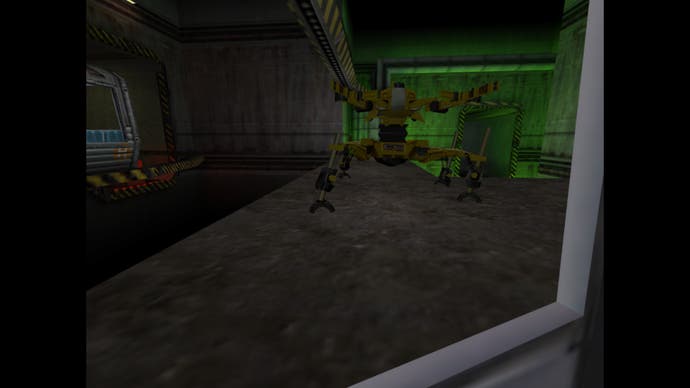
And still! And still I can't stop thinking of that opening to the first game. The tram ride. The facility deep in the desert. The shooter that kicks off with no shooting.
I booted it up again last week just to check what it felt like now, after 20 years. And it still feels audacious. You're on this tram. The credits are appearing. And the game is telling you a couple of simple things over a long period of time as you go on and on, deeper and deeper. It is telling you: this place is really big, and you are a really small part of it, and if you're going further and further and further into it it must mean that you're going to have to make your way back out at some point.
That's the narrative stuff anyway. It's telling you about the place where you work and all the hazardous stuff you work around - the giant cargo mechs, the pools of Simpsons-green radioactive gunk. Part of me, even on the first time through, was watching all that and taking note: will I have to shoot one of those mechs at some point? Will I have to navigate all that goop?
But there's lots of other stuff going on too. The voice over the tannoy, telling you about the temperature outside, telling you this and that about the company, telling you that if you have friends who might be up for working here there are openings. Half-Life isn't just showing you the kind of environments you're moving through and suggesting how screwed you are going to be in five minutes or so when everything goes wrong. It is building the culture of the game's arrogant and complacent military-industrial-complex world, suggesting the kind of bland bureaucratic evil that would come to the fore in the gorgeous beige PowerPoint comedy of Portal years into the future.
And it's doing more too. Even back then I detected a hint of admonishment in Half-Life, a suggestion, to everyone else making first-person shooters, that this stuff was not really that hard was it? That a classy, slow-burn opener shouldn't have taken quite so long to arrive on peoples' PCs. When I heard a few weeks back that Half-Life was coming up to 20, I immediately thought: oh man, I should write a piece about how its opening section was the first walking simulator. "That will really put the cat among the pigeons!" Then I realised that thought was stupid, for so many obvious reasons. But once the thought has passed, I realised that the games we now - often reluctantly - call walking simulators frequently share something crucial with the start of Half-Life. Okay two things: the absence of a weapon in a first-person perspective where we're used to see a gun barrel jogging along at the bottom of the screen, but also that sense of an unspoken rebuke to other games, that violence from the get-go may be the easiest option, but is it the most interesting? Is it the most effective option in terms of pacing, in terms of storytelling and world-building, in terms of exploring what games can be and what they can do?
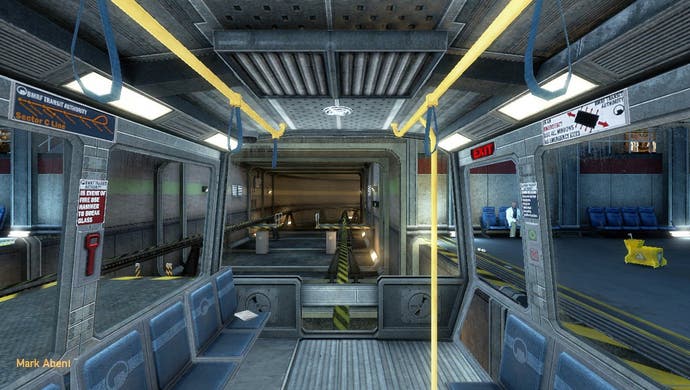
(Talking of walking simulators, I love that Virginia has a sequence that could almost be a one-upping of Half-Life's tram-ride: a journey down into the deep basement of an office block, told in three brisk cuts and the space of about two seconds.)
Wonderfully, returning to Half-Life at 20 made me realise, more than anything, how much I had forgotten. When I got off the tram, I realised I had almost entirely run out of memories. This tram is what I remember of Half-Life, and it's obviously not the entirety of the game, and not even the entirety of the game's opening. Because I am boring, I timed it: Got on the tram at 11.23. Got off the tram at 11.28. (I think there may have been a bug that stopped the tram when I moved too freely about the carriage.) Then, I had to wait until 11.41 before I got the crowbar. After the tram the walking continues: into work, the guard tells me I'm late, everyone's very excited about the test, the computer malfunction hints at all kinds of problems, into the special suit, and down to the test chamber. 11.41 until I get the crowbar! Not bad, Valve. Not bad.
And this one last thing - it might be what Hitchcock liked to call the icebox moment, the detail that sticks in your head and bothers you - that I had never noticed before. In Freeman's locker at work a picture of a baby. Whose baby? I can't remember if this gets tied up neatly somewhere else in the rest of the Half-Life fiction, but if it doesn't? Well that's a question for which I am more than willing to wait for the answer.
